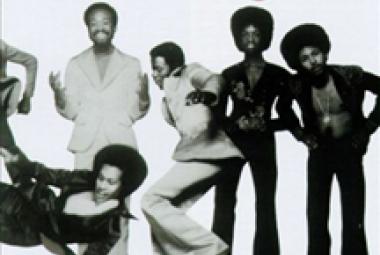Link Wray’s influence is front and center on a good 50% of the records that I play, because he is credited with introducing the “power chord” on electric guitar to rock and roll, a technique whose effect is often enhanced by distortion.
Writing for Allmusic, Cub Koda calls the power chord “the major modus operandi of modern rock guitarists”. I will spare you the technical details – not least because I don’t really understand them myself – but Ray Davies of the Kinks (in their classic “You Really Got Me”) and Pete Townshend of the Who (in “My Generation”) helped popularize the power chord in the early years of the British Invasion. When Townshend is performing his famous windmill guitar technique, he is typically playing power chords.
(February 2013)
* * *
The trouble with introducing yourself to the public as a novelty act is that no one tends to take your follow-up recordings seriously. One of the best new wave albums I have acquired in recent years is Dangerous Dreams by the Nails; and Allmusic (specifically Whitney Z. Gomes) states the problem well in their review of the album: “Now a new wave novelty, and forever burdened with a ‘one-hit wonder’ albatross because of the monolithic ‘88 Lines About 44 Girls’, the Nails demonstrate on Dangerous Dreams that this Boulder, CO band still held some clever moves in their repertoire. . . . The grandeur of the Doors, the propulsion of Iggy Pop, and the moroseness of the Sisters of Mercy, combine with the Nails’ own talent to create the perfect vessel for riding high on a dark wave of depression.” However, with all of that praise, the album still merited only a 2½-star rating.
* * *
Tiny Tim’s albums were remarkably good; Allmusic gives his debut album, God Bless Tiny Tim four stars, and it features his takes on several classic tunes, some corny ghost stories, and other fun stuff. On his follow-up album, Tiny Tim’s Second Album, Tiny Tim posed with his parents; and his third album, For All My Little Friends (a collection of children’s songs), was nominated for a Grammy.
(March 2013)
* * *
If I had to succinctly characterize the current musical period – having just watched the first hour of the 2013 Billboard Music Awards – I would use the phrase “overdoing it”. American Idol and the other television singing contests encourage contestants to go all out in their performances, and that attitude has suffused much of today’s music. On at least one occasion, I have heard one of the renowned producers who craft many of today’s hit songs (I forget who exactly) piece one together in a few minutes on National Public Radio during an interview, so studio wizardry has also become available to just about anyone – and it is all too tempting to take that too far. Refreshingly, Hollis Brown holds back in this regard; as Steve Leggett of Allmusic puts it in their rave review of their album Ride on the Train: “[The album has] a sharp, taut sound that only includes what is necessary to put the song over. . . . This is a band with a bright future.”
(May 2013)
* * *
Writing for Allmusic, rock critic Bruce Eder states his case well: “Buddy Holly is perhaps the most anomalous legend of ’50s rock & roll – he had his share of hits, and he achieved major rock & roll stardom, but his importance transcends any sales figures or even the particulars of any one song (or group of songs) that he wrote or recorded. Holly was unique, his legendary status and his impact on popular music all the more extraordinary for having been achieved in barely 18 months. . . . In a career lasting from the spring of 1957 until the winter of 1958-1959 – less time than Elvis had at the top before the army took him (and less time, in fact, than Elvis spent in the army) – Holly became the single most influential creative force in early rock & roll. . . .
“Holly and the band weren’t afraid to experiment even on their singles, so that ‘Peggy Sue’ made use of the kind of changes in volume and timbre on the guitar that were usually reserved for instrumental records; similarly, ‘Words of Love’ was one of the earliest successful examples of double-tracked vocals in rock & roll, which the Beatles, in particular, would embrace in the ensuing decade.”
* * *
As important as he is in his home country, the influence of Buddy Holly among British musicians is incalculable. Quoting Bruce Eder again: “The group’s heavy use of rhythm guitar slotted right in with the sound of skiffle music, a mix of blues, folk, country, and jazz elements that constituted most of British youth’s introduction to playing music and their way into rock & roll. Additionally, although he cut an exciting figure on-stage, Holly looked a lot less likely arock & roll star than Elvis – tall, lanky, and bespectacled, he looked like an ordinary guy who simply played and sang well, and part of his appeal as a rock & roll star was rooted in how unlikely he looked in that role. He provided inspiration – and a way into the music – for tens of thousands of British teenagers who also couldn’t imagine themselves rivals to Elvis or Gene Vincent in the dark and dangerous department. . . . Additionally, although he played several different kinds of guitar, Holly was specifically responsible for popularizing – some would say elevating to mystical, even magical status – the Fender Stratocaster, especially in England.”
* * *
The extravagant glasses that Elton John has worn throughout his decades-long career all started when young Reg Dwight began wearing glasses in his teens “not because he needed them, but in homage to Buddy Holly”, as Philip Norman wrote in his biography of the English legend. Lead singer Freddie Garrity of Freddie and the Dreamers is another British star who wore Buddy Holly glasses on stage; in the 1970’s, pub-music star Elvis Costello was doing the same. Allmusic describes Freddie and the Dreamers as “the clowns of the British Invasion” due to their outlandish hits like “Do the Freddie”, but there is a lot more to them than that (though I will have to get into that another time).
* * *
Quoting Riche Unterberger in Allmusic: “One of the original rock & roll greats, Little Richard merged the fire of gospel with New Orleans R&B, pounding the piano and wailing with gleeful abandon. While numerous other R&B greats of the early ’50s had been moving in a similar direction, none of them matched the sheer electricity of Richard’s vocals. With his bullet-speed deliveries, ecstatic trills, and the overjoyed force of personality in his singing, he was crucial in upping the voltage from high-powered R&B into the similar, yet different, guise of rock & roll.”
Any in-depth discussion of Bob Dylan inevitably comes to the supposedly controversial and dramatic “going electric”, where he was booed at some concerts and called “Judas” at another. The single “Mixed Up Confusion” – the very first 45 released by Dylan – muddies those waters considerably, and this is perhaps the reason that this ground-breaking recording is given short shrift in both Wikipedia and Allmusic. In fact, I found almost nothing about the song except YouTube videos, lyric sheets, download sites, and the other usual Internet folderol.
* * *
Brian Wilson was the bandleader and primary songwriter of the Beach Boys; writing for Allmusic, William Ruhlmann says that Brian Wilson “is arguably the greatest American composer of popular music in the rock era”. In the beginning, there were fun songs about surfing and cars and girls, as well as a (more or less) friendly rivalry with Jan & Dean that prefigured the more contentious Beatles vs. Stones debates. It is no secret that Jan Berry – a wunderkind in his own right – wasn’t happy that the Beach Boys copied the surf sounds that Jan & Dean pioneered.
* * *
John Bush in Allmusic says of the background behind this classic: “‘Good Vibrations’, the Beach Boys’ 1966 entry into the best-single-of-all-time sweepstakes, announced the coming era of pop experimentation with a rush of riff changes, echo-chamber effects, and intricate harmonies, plus the very first theremin ever heard on a pop record. The natural grace of the song belied the months of recording and mountain of tape reels it required, however. Though Brian Wilson’s self-described ‘pocket symphony’ was his masterpiece, its creation effectively put the coda on his production career, and he was never the same again. . . . In the end, ‘Good Vibrations’ cost over 50,000 dollars to produce, making it one of the most expensive singles recorded up to that point.”
* * *
Brian Wilson brought in a talented collaborator for the SMiLE project, Van Dyke Parks. In Allmusic, William Ruhlmann says of him: “In a field where the term ‘genius’ is handed out freely, Van Dyke Parks is the real article. As a session musician, composer, arranger, lyricist, and singer, he’s contributed significantly to several decades’ worth of inimitable masterpieces credited to other artists, as well as generating two or three masterpieces of his own.”
(June 2013/2)
* * *
Anyway, word’s out now about the Klubs, even if no one has gotten around to putting anything in Wikipedia or Allmusic about them. The band has a website – www.theklubs.com/ – and they also have a listing on the online British Music Archive: www.britishmusicarchive.com/K/339-the-klubs .
(July 2013)
* * *
Buffy Sainte-Marie’s first album, It’s My Way! (1964) is described by William Ruhlmann for Allmusic as “one of the most scathing topical folk albums ever made. . . . Even decades later, the album’s power is moving and disturbing.”
I was scanning the song list on It's My Way! and spotted another song that came up in a different context: “You’re Going to Need Somebody on Your Bond”. As with every song on It's My Way! but one, the songwriter was listed as Buffy Sainte-Marie on the Allmusic listing for the album. I actually said out loud when I saw that: “Really?!” – where I remembered it was on the most recent album by the psychedelic hard rock band the Deviants, Dr. Crow.
* * *
I laughed out loud when I first read the review of Dr. Crow by Dave Thompson for Allmusic, because it is all so true for us Deviants fans: “The thing with the Deviants is, either you love everything they do – in which case Dr. Crow is their most thrilling new release in the six years since their last one – or you just don’t get it. Sadly for the band’s dreams of world domination, most people tend to fall into the latter category; but anybody who has pursued mainman Mick Farren across the last 35 years of sonic and literary guerilla-ism will have Dr. Crow cranked up as loud as is humanly tolerable, not caring a toss for what the neighbors think. Because in the Deviants’ world, the neighbors don’t think – their brains aren’t big enough.”
(August 2013)
* * *
As with many of my later Wikipedia articles as well as the UARB and UARA posts, I relied largely on information given on the Allmusic website, the best source that I have found about older rock bands and artists. Surprisingly, after I wrote up the Wikipedia article on the Head Shop, the Eugene Chadbourne piece about the band on Allmusic disappeared, even though Chadbourne still has several other pieces on other rock bands. I have often thought that I should question them about that, wondering if they were aiming to be “Somemusic” rather than Allmusic. I later found the Chadbourne piece on www.barnesandnoble.com, though that one is gone as well. I just found something by Eugene Chadbourne about the Head Shop on Allmusic, but it was filed under the artist Joe? and seems to be mostly a gag piece.
* * *
Allmusic has a glowing 4½-star review of Beautiful Debris, as written by Ned Raggett: “It’s a fun and accurate album title, Beautiful Debris, collecting the quite wonderful and indeed more often than not sweetly beautiful output of Blair 1523. . . . Compiling both the EP and unreleased tracks, it makes a solid case for Blair 1523 as underrated modern psych gods, mixing a fun kick-up-your-heels rave-up sense – ‘Swell’ is particularly great on this level – with some drone feedback zone-outs to good effect.”
* * *
There are actually a lot of websites out there that talk about Blair 1523: It might be surprising to some that a search of the band name in quotes brings up 18,100 hits on Google. The first page of Google hits has a YouTube video of “Fantasy of Folk”, the Bomp! Mailorder site where the “last copies” of the CD can still be purchased plus another listing on Amazon.com, the mention of the band in my Wikipedia article on the Outcasts, the Allmusic review and the Julian Cope blog mentioned above, a listing on last.fm that actually has some information and even a photo of Blair 1523, and more barren listings on mtv.com, Discogs, and Rate Your Music. Further Google pages bring up other barebones listings – the one on Ticketmaster that offers concert tickets and tour schedules for a band that broke up 20 years ago is particularly hilarious – and other places to buy the CD and rate the music and see the lyrics and download “free” MP3’s (Napster lives!).
(September 2013)
* * *
Another band from the same time period, the Go-Go’s became popular even beyond their hit songs and albums. Their first album, the triple-platinum Beauty and the Beat is one of the top selling debut albums of all time and is described by Stephen Thomas Erlewine in Allmusic as being “one of the cornerstone albums of American new wave”.
(November 2013)
* * *
Upon the death of Lou Reed in October 2013, the Velvet Underground has been celebrated once again. Allmusic calls them “the quintessential bohemian New York band of the ’60s that fused art, rock, and poetry in a fashion that proved incalculably influential”.
* * *
After the Velvet Underground broke up, Lou Reed mounted a decades-long solo career that started with a bang: “Walk on the Wild Side” is hard to top as an I-can’t-believe-what-I’m-hearing song, but it was as irresistible in 1972 as it is today and made it to #16 on the Billboard singles charts. In 1989, he released his long-ranging album New York; as identified as Lou Reed is with New York City, he needed to bring the goods if he was going to use that album name, and does he ever. Allmusic calls New York the finest solo album of Lou Reed’s career.
* * *
I saw the above album by Angie Pepper, It’s Just that I Miss You (2001) that was advertised in the Bomp! mailorder service as recommended for Blondie and Patti Smith fans, so I immediately ordered it. Allmusic calls her music psychedelic blues-rock and compares her to Janis Joplin.
* * *
Dyan Diamond of Venus and the Razorblades released an acclaimed album in 1978 (produced by Kim Fowley), In the Dark that brings rockabilly and roots music to her new wave oeuvre; Allmusic gives the album 4½ stars and called it “a perfect example of an LP that was a creative triumph but a commercial disappointment”.
* * *
Writing for Allmusic, Ned Raggett says of the Les Hell on Heels CD: “If one word can cover everything here, it's ‘swagger’ – songs like ‘He’s Alright’ and ‘Waste of Time’ could almost coin the term in both the singing and the brawling, rolling punch of the band (big credit to both Chela LaRue and drummer Kristin Machynski).” That's not the only word Raggett introduces though; he calls the band’s music “snot-garage”.
(December 2013)
* * *
I also keep these pieces personally informative; in short, I learn a lot myself from putting these Facebook Notes together. While most of the kernels of what I write about are lodged in my brain somewhere, I coax the details from simple Google searches, with my primary sources being Wikipedia and Allmusic. For the UARB’s and UARA’s, I sometimes find myself mounting searches for hours. I often put in extended quotes that I find on-line, particularly for matters that I don’t know too much about. That is perfectly fine with Wikipedia, but not so much with other Internet source material.
* * *
It was Dara Gould who got me to sign up for Facebook, sometime in late 2009. Not really knowing what to do with Facebook now that I was on it, I made a modest announcement on November 10, 2009:
Coming soon: UNDER-APPRECIATED ROCK BAND OF THE MONTH. An article in Discover Magazine once said that the “beloved, unwieldy” Wikipedia included “scads of articles on virtually unknown rock bands”. I had to laugh out loud since I have done my part to add to those scads! Still, many great bands don’t yet have a Wikipedia article, or even an entry on “Allmusic”: www.allmusic.com. So I will try to remedy that.
(Year 5 Review)















